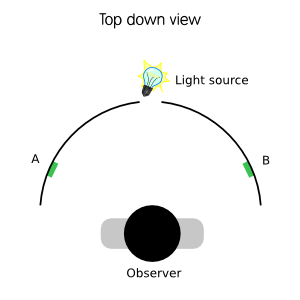Have you ever heard that the eye is like a camera? Generally that’s true. But look through a camera and move it from side to side. Notice the churning sensation in your gut and how it feels like you’re watching the car chase scene from The Bourne Supremacy all over again. Now move your eyes from side to side. Immediately you’ll notice a significant difference. We normally don’t loose our last meal every time we look around with our eyes.
 The brain is very good at minimizing sensory input so we don’t get over stimulated. (Autism is where the brain doesn’t do it’s job and allows too much stimulation, making it extremely difficult to pay attention to anything.) A camera, on the other hand, can’t filter out motion.
The brain is very good at minimizing sensory input so we don’t get over stimulated. (Autism is where the brain doesn’t do it’s job and allows too much stimulation, making it extremely difficult to pay attention to anything.) A camera, on the other hand, can’t filter out motion.
Experiment #1
Ok, ok, enough suspense. Let’s find out how the brain filters motion. To demonstrate this phenomenon, let’s set up an experiment, which I actually did in optometry school. An observer is seated in front of a large section of construction paper at eye level bend into a semicircle. Points A and B are just marks on the paper. Directly in front of the observer is a narrow cut-out section through which a light is seen. (Here’s the impressive part.) If the observer looks at point A then quickly looks at point B (or vice versa) the light is not seen. During this quick movement, we know at one point the eyes were briefly pointed directly at the light. Why didn’t we see the light? The phenomenon here is that actually the eye DID see the light, but the brain didn’t.
Experiment #2
Just about everyone has already done this experiment. Simply sit in a rotating chair and spin yourself really fast. Did you get dizzy? Ready for a second chance to taste that spinach salad with walnuts you had for lunch? The spinning simulated quick eye movements just like shifting our eyes from points A to B, but why did we get dizzy this time?
The Brain Categorizes the Type of Motion
To filter the visual sensation of motion, the brain considers not only the motion the retina sees but also if the eye is in motion at the time and if the motion was initiated by choice (voluntary) or forced (involuntary). Imagine (don’t try this yourself) numbing up the eye, then someone gently grabbing the white part of your eye with tweezers and having that person moving your eye side to side for you. (We actually do this in the exam room on certain patients to determine neurological dysfunctions.) You would get dizzy because your brain isn’t filtering out the motion.
Wow! That’s Cool!
Let’s put this all together now. Here’s a play-by-play of what happened in our experiment #1 that caused the brain to filter.
- The observer looks at point A.
- The observer starts to move their eye away from point A.
- The retina, sensing an image moving across it, sends impulses to the brain. (But, as we saw from experiment #2 and the tweezer test, this isn’t enough for the brain to filter.)
- Nerve impulses are sent to the brain from the eye muscles that initiated the movement. This combination of retina and muscle input tells the brain that the observer made a voluntary eye movement.
- The brain shuts down the visual system for a split second during the eye movement. This is called visual suppression. We’ve been using the layperson term “filtering” in this post.
- Once the eye reaches point B, the retina and muscles send impulses again to the brain telling it the eye movement has stopped.
- The brain turns the visual system on again. That explains why we don’t see the light in experiment #1.
You, being the bright person that you are, would now ask, “Why don’t we see black when the brain turns the visual system off?” This is quite a complex process, but suffice it to say, the brain has the amazing ability to cover up visual interruptions. Our world doesn’t go black each time we blink either. I may go into more detail on this in a future post.